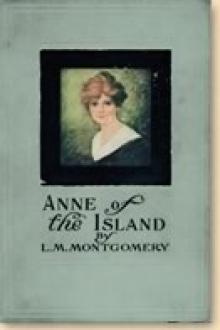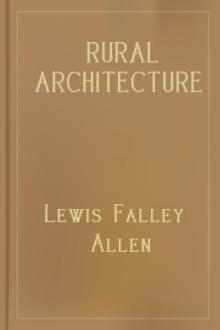A History of Art for Beginners and Students, Clara Erskine Clement Waters [best beach reads .txt] 📗

- Author: Clara Erskine Clement Waters
- Performer: -
Book online «A History of Art for Beginners and Students, Clara Erskine Clement Waters [best beach reads .txt] 📗». Author Clara Erskine Clement Waters
His home now became famous for its hospitable reunions, and his social position, added to his artistic merits, procured for him orders beyond his utmost ability to fill. One after another in quick succession, large, grand works were sent out from his studio to be the pride of churches and convents. At this time his pictures were noted for a portrait-like naturalness in their faces, perhaps lacking in idealism, but withal pure and pleasing; the drapery graceful and well arranged, the lights skilfully disposed, the tints harmonious, and the contours soft. His flesh tints were heightened by dark gray backgrounds, so amazingly true that an admirer has said they were painted in blood and milk. The calido, or warm manner, was preserved for eight or ten years. In this style were painted an “Immaculate Conception,” for the Franciscan Convent; “The Nativity of the Virgin,” for the high altar of the Seville Cathedral; a “St. Anthony of Padua” for the same church, and very many others equally famous. In 1874 the St. Anthony was stolen from the cathedral, and for some time was unheard of, until two men offered to sell it for two hundred and fifty dollars to Mr. Schaus, the picture dealer in New York. He purchased the work and turned it over to the Spanish Consul, who immediately returned it to the Seville Cathedral, to the great joy of the Sevillians. In 1658 Murillo turned his attention to the founding of an Academy of Art, and, though he met with many obstacles, the institution was finally opened for instruction in 1660, and Murillo was its first president. At this time he was taking on his latest manner, called the vaporoso, or vapory, which was first used in some of his pictures executed for the Church of Sta. Maria la Blanca. In this manner the rigid outlines of his first style is gone; there is a feathery lightness of touch as if the brush had swept the canvas smoothly and with unbroken evenness: this softness is enhanced by frequent contrasts with harder and heavier groups in the same picture.
But the highest point in the art was reached by Murillo in the eleven pictures which he painted in the Hospital de la Caridad. Six of these are now in their original places; five were stolen by Soult and carried to France; some were returned to Spain, but not to the hospital.
The convent of the Capuchins at Seville at one time possessed twenty pictures by this master. The larger part of them are now in the Museum of Seville, and form the finest existing collection of his works. This museum was once a church, and the statue of Murillo is placed in front of it. Although the lighting of this museum is far inferior to that of Madrid and many others, yet here one must go to realize fully the glory of this master. Among the pictures is the “Virgen de la Sevilletá,” or Virgin of the Napkin. It is said that the cook of the convent had become the friend of the painter, and begged of him some memento of his good feeling; the artist had no canvas, and the cook gave him a napkin upon which this great work was done.
In the Louvre.
Murillo’s representation of that extremely spiritual and mystical subject called the Immaculate Conception, has so far excelled that of any other artist that he has sometimes been called “the painter of the Conception.” His attention was especially called to this subject by the fact that the doctrine it sets forth was a pet with the clergy of Seville, who, when Pope Paul V., in 1617, published a bill making this doctrine obligatory, celebrated the occasion with all possible pomp in the churches; the nobles also gave entertainments, and the whole city was alive with a fervor of religious zeal and a desire to manifest its love for this dogma. The directions given by the Inspector of the Holy Office for the representation of this subject were extremely precise; but Murillo complied with them in general effect only, and disregarded details when it pleased him: for example, the rules prescribed the age of the Virgin to be from twelve to thirteen, and the hair to be of golden hue. Murillo sometimes pictured her as a dark-haired woman. It is said that when he painted the Virgin as very young his daughter Francesca was his model; later the daughter became a nun in the convent of the Madre de Dios.
The few portraits painted by Murillo are above all praise; his pictures of humble life, too, would of themselves have sufficed to make him famous. No Spanish artist, except Velasquez, has painted better landscapes than he. But so grand and vast were his religious works that his fame rests principally on them. It is true, however, that in England and in other countries out of Spain he was first made famous by his beggar boys and kindred subjects.
Murillo and Velasquez may be said to hold equivalent positions in the annals of Spanish Art—Murillo as the painter for the church, and Velasquez as that of the court. As a delineator of religious subjects Murillo ranked only a very little below the greatest Italian masters, and even beside them he excels in one direction; for he is able more generally and fully to arouse religious emotions and sympathies. This stamps his genius as that of the first order, and it should also be placed to his credit, in estimating his native talent, that he never saw anything of all the Classic Art which was such a source of inspiration to the artists of Italy. Stirling says: “All his ideas were of home growth: his mode of expression was purely national and Spanish; his model—nature, as it existed in and around Seville.”
While painting a marriage of St. Catherine for the Capuchin Church of Cadiz, Murillo fell from the scaffold, and soon died from his injuries: he was buried in the Church of Sta. Cruz, and it is a sad coincidence that this church and that of San Juan, at Madrid, in which Velasquez was interred, were both destroyed by the French under the command of Soult.
The character of Murillo was such as to command the greatest respect, and though he was not associated with as many royal personages as Velasquez, he was invited to court, and received many flattering acknowledgments of his genius. His fame was not confined to his own country, and his portrait was engraved in Flanders during the last year of his life. He had many strong personal friends, and his interest in the academy and his generosity to other artists prove him to have been above all mean jealousies: he loved Art because it was Art, and did all in his power for its elevation in his own country. It is probable that since his death more money has been paid for a single picture by him than he received for the entire work of his life. The Immaculate Conception, now in the Louvre, was sold from the Soult collection for six hundred and fifteen thousand three hundred francs, or more than one hundred and twenty-three thousand dollars. At the time of its sale it was believed to be the largest price ever paid for a picture.
Sebastian Gomez (about 1620) was a mulatto slave of Murillo’s, and like Pareja he secretly learned to paint. At last one day when Murillo left a sketch of a head of the Virgin on his easel Gomez dared to finish it. Murillo was glad to find that he had made a painter of his slave, and though the pictures of Gomez were full of faults his color was much like that of his master. Two of his pictures are in the Museum of Seville. He did not live long after Murillo’s death in 1682.
Don Alonso Miguel de Tobar (1678-1758) never attained to greatness. His best original pictures were portraits. He made a great number of copies of the works of Murillo, and was chiefly famous for these pictures. There is little doubt that many pictures attributed to Murillo are replicas, or copies by the hand of Tobar.
The school of Valencia flourished from 1506 to 1680. Vicente de Joanes (about 1506-1579) was a painter of religious pictures who is scarcely known out of Spain, and in that country his pictures are, almost without exception, in churches and convents. He was very devout, and began his works with fasting and prayer. It is related that on one occasion a Jesuit of Valencia had a vision in which the Virgin Mary appeared to him, and commanded him to have a picture painted of her in a dress like that she then wore, which was a white robe with a blue mantle. She was to be represented standing on a crescent with the mystic dove floating above her; her Son was to crown her, while the Father was to lean from the clouds above all.
The Jesuit selected Joanes to be the painter of this work, and though he fasted and prayed much he could not paint it so as to please himself or the Jesuit. At last his pious zeal overcame all obstacles, and his picture was hung above the altar of the Immaculate in the convent of the Jesuits. It was very beautiful—the artists praised it, the monks believed that it had a miraculous power, and it was known as “La Purisima,” or the perfectly pure one.
Joanes excelled in his pictures of Christ. He seemed to have conceived the very Christ of the Scriptures, the realization of the visions of St. John, or of the poetry of Solomon. In these pictures he combined majesty with grace and love with strength. Joanes frequently represented the Last Supper, and introduced a cup which is known as the Holy Chalice of Valencia. It is made of agate and adorned with gold and gems, and was believed to have been used by Christ at his Last Supper with his disciples. Some of the portraits painted by Joanes are very fine. In manner and general effect his works are strangely like those of the great Raphael.
Francisco de Ribalta (1550-1628) was really the head of the school of Valencia, and one of the best historical painters of Spain. He studied his art first in Valencia, and there fell in love with the daughter of his master. The father refused him his suit, and the young couple parted in deep sorrow. Ribalta went to Italy, where he made such progress, and gained such fame that when he returned to Valencia he had no trouble in marrying his old master’s daughter. Valencia has more pictures by Ribalta than are found elsewhere. Out of Spain they are very rare. One of his





Comments (0)